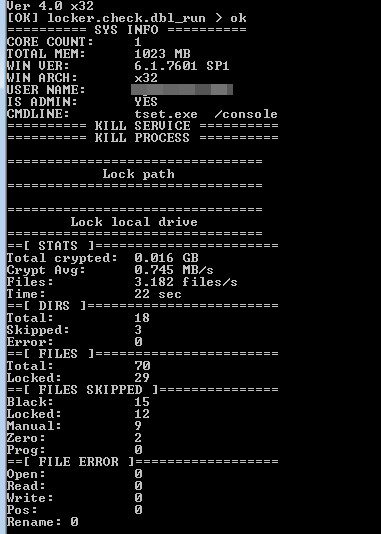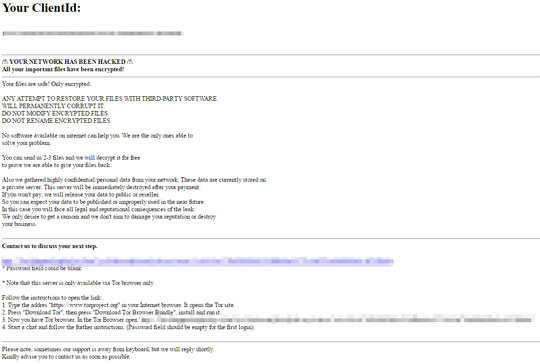Ransom.Win32.ASTROLOCKER.A
BScope.TrojanRansom.Encoder (VBA32)
Windows


Threat Type: Ransomware
Destructiveness: No
Encrypted: Yes
In the wild: Yes
OVERVIEW
This Ransomware arrives on a system as a file dropped by other malware or as a file downloaded unknowingly by users when visiting malicious sites.
It executes then deletes itself afterward.
It drops files as ransom note. It avoids encrypting files with the following file extensions.
TECHNICAL DETAILS
Arrival Details
This Ransomware arrives on a system as a file dropped by other malware or as a file downloaded unknowingly by users when visiting malicious sites.
Installation
This Ransomware drops the following files:
- %User Temp%\{random 8 characters}.bat
- {Malware Path\Malware File Name and Extension}.log - log file where core count, total memory, OS Information, username, commandline, encrypted files, and malware sample's performance statistics are listed
(Note: %User Temp% is the current user's Temp folder, which is usually C:\Documents and Settings\{user name}\Local Settings\Temp on Windows 2000(32-bit), XP, and Server 2003(32-bit), or C:\Users\{user name}\AppData\Local\Temp on Windows Vista, 7, 8, 8.1, 2008(64-bit), 2012(64-bit) and 10(64-bit).)
It executes then deletes itself afterward.
It adds the following mutexes to ensure that only one of its copies runs at any one time:
- {32 Hex Characters generated from Volume Serial ID}
Other System Modifications
This Ransomware adds the following registry entries as part of its installation routine:
HKEY_CURRENT_USER\Software\Classes\
.{Generated ID}\shell\Open
(Default) = explorer.exe RecoveryManual.html
Process Termination
This Ransomware terminates the following services if found on the affected system:
- database
- msexchange
It terminates the following processes if found running in the affected system's memory:
- msftesql.exe
- sqlagent.exe
- sqlbrowser.exe
- sqlwriter.exe
- oracle.exe
- ocssd.exe
- dbsnmp.exe
- synctime.exe
- agntsvc.exe
- isqlplussvc.exe
- xfssvccon.exe
- sqlservr.exe
- mydesktopservice.exe
- ocautoupds.exe
- encsvc.exe
- firefoxconfig.exe
- tbirdconfig.exe
- mydesktopqos.exe
- ocomm.exe
- mysqld.exe
- mysqld-nt.exe
- mysqld-opt.exe
- dbeng50.exe
- sqbcoreservice.exe
- excel.exe
- infopath.exe
- msaccess.exe
- mspub.exe
- onenote.exe
- outlook.exe
- powerpnt.exe
- thebat.exe
- steam.exe
- thebat64.exe
- thunderbird.exe
- visio.exe
- winword.exe
- wordpad.exe
- QBW32.exe
- QBW64.exe
- ipython.exe
- wpython.exe
- python.exe
- dumpcap.exe
- procmon.exe
- procmon64.exe
- procexp.exe
- procexp64.exe
Information Theft
This Ransomware accepts the following parameters:
- /console - displays the following console window

- /nolog - disable the creation of the log file in the malware directory
- /scan: - specifies what drive type to encrypt
- /marker:{filename} - drops file in infected drive that serves as an infection marker
- /fullpd - encrypts %ProgramData%
- /nodel - disables self deletion after execution
- /nokill - disable process termination
- /fast:{value} - specifies which bytes to encrypt for faster file encryption
- /onlypath /path:{path} - only encrypts a specific path
Ransomware Routine
This Ransomware avoids encrypting files with the following strings in their file name:
- RecoveryManual.html
- ReadManual.{Generated ID}
It avoids encrypting files with the following strings in their file path:
- \WindowsApps\
- \Microsoft\Windows\
- \Roaming\Microsoft\
- \Local\Microsoft\
- \LocalLow\Microsoft\
- \Local\Packages\
- \Windows Defender\
- \microsoft shared\
- \Google\Chrome\
- \Mozilla Firefox\
- \Mozilla\Firefox\
- \Internet Explorer\
- \MicrosoftEdge\
- \Tor Browser\
- \AppData\Local\Temp\
It avoids encrypting files found in the following folders:
- {Drive Letter}:\Windows\
- {Drive Letter}:\System Volume Information\
- {Drive Letter}:\$RECYCLE.BIN\
- {Drive Letter}:\SYSTEM.SAV
- {Drive Letter}:\WINNT
- {Drive Letter}:\$WINDOWS.~BT\
- {Drive Letter}:\Windows.old\
- {Drive Letter}:\PerfLog\
- {Drive Letter}:\Boot
- {Drive Letter}:\ProgramData\Packages\
- {Drive Letter}:\ProgramData\Microsoft\
It appends the following extension to the file name of the encrypted files:
- .ReadManual.{Generated ID}
It drops the following file(s) as ransom note:
- {Encrypted Folder}\RecoveryManual.html

It avoids encrypting files with the following file extensions:
- exe
- dll
- sys
- msi
- mui
- inf
- cat
- bat
- cmd
- ps1
- vbs
- ttf
- fon
- lnk
SOLUTION
Step 1
Before doing any scans, Windows 7, Windows 8, Windows 8.1, and Windows 10 users must disable System Restore to allow full scanning of their computers.
Step 2
Note that not all files, folders, and registry keys and entries are installed on your computer during this malware's/spyware's/grayware's execution. This may be due to incomplete installation or other operating system conditions. If you do not find the same files/folders/registry information, please proceed to the next step.
Step 3
Identify and terminate files detected as Ransom.Win32.ASTROLOCKER.A
- Windows Task Manager may not display all running processes. In this case, please use a third-party process viewer, preferably Process Explorer, to terminate the malware/grayware/spyware file. You may download the said tool here.
- If the detected file is displayed in either Windows Task Manager or Process Explorer but you cannot delete it, restart your computer in safe mode. To do this, refer to this link for the complete steps.
- If the detected file is not displayed in either Windows Task Manager or Process Explorer, continue doing the next steps.
Step 4
Delete this registry value
Important: Editing the Windows Registry incorrectly can lead to irreversible system malfunction. Please do this step only if you know how or you can ask assistance from your system administrator. Else, check this Microsoft article first before modifying your computer's registry.
- In HKEY_CURRENT_USER\Software\Classes\.{Generated ID}\shell\Open
- (Default) = explorer.exe RecoveryManual.html
- (Default) = explorer.exe RecoveryManual.html
Step 5
Search and delete this file
Step 6
Scan your computer with your Trend Micro product to delete files detected as Ransom.Win32.ASTROLOCKER.A. If the detected files have already been cleaned, deleted, or quarantined by your Trend Micro product, no further step is required. You may opt to simply delete the quarantined files. Please check the following Trend Micro Support pages for more information:
Step 7
Restore encrypted files from backup.
Did this description help? Tell us how we did.


